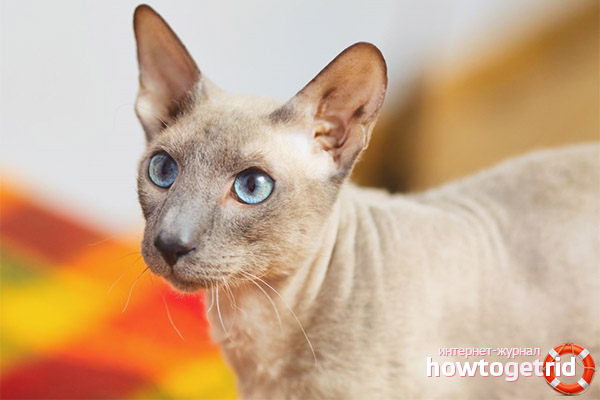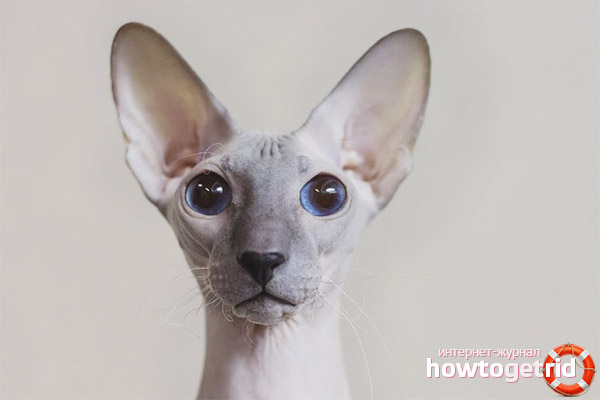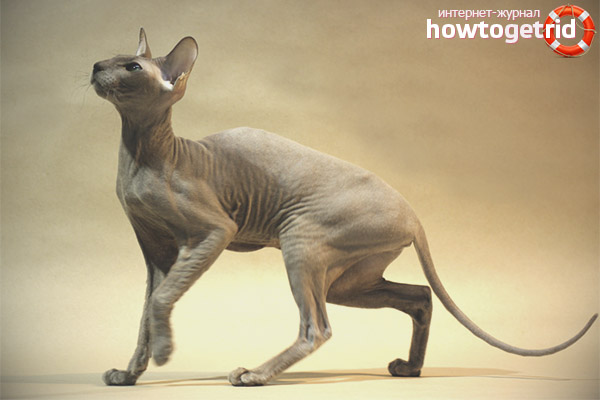The content of the article
In 1996, the Peterbald cat breed was registered with the SFF Breeding Federation. Then the main standard of this cat breed was determined. The St. Petersburg sphinx originates from the ancestor of Nocturne. He was born from a cat-mother of German blood Radma von Jagerhov and cat-father - the Don sphinx Athenogen Myth. Russia became the birthplace of the new breed, however today peterbalds are also loved in other countries.
Breed description
The cat breed of the St. Petersburg Sphinx is the epitome of elegance and grace. It can often be found on the covers of glossy magazines. Petersburgers have such a breed standard:
- The head is narrow, has elongated shapes and a peculiar bend-transition.
- The nose is long. The head profile is straight, proud and thin, inherent in the royal cats of Cleopatra.
- Ears are large with wide bases, with divorced tips. English set-up of ears for this breed is appreciated - when they can hold the laid sheet. Together, the head and ears resemble a sharp blade.
- Eyes are almond-shaped and slightly slanted.
- The body is elongated and tubular. The hips and shoulders of the animal are equivalent in terms of width. Groin is not picked up.
- The limbs are very slender and tall. They have outstretched fingers and dense pads. A significant disadvantage is the curvature of the cat's paws.
Particular emphasis is placed on the tail of the animal. It is quite thin at the very base. In the breed standard, tail fracture and curvature are excluded.
As for color, the St. Petersburg Sphinx is of a different palette. Particular colors, color points, chocolate, lilac and cream colors are appreciated. Cats are rarely monophonic. White, red, gray monochromatic colors are extremely rare. Kittens can be painted with various spots, which completely allows the breed standard.
Petersburgers are not always completely naked and without hair. There are such varieties of these cats:
- Brush - newborn kittens have a small undercoat, with which they part, growing up.
- Brush point - kittens have very short hair, and even a fluffy tail. By adulthood, wool remains only on the muzzle and legs. The body of an adult sphinx is completely devoid of hair.
- Velor - by the year a small wool remains only on the paws and face. Sometimes an animal can be completely exposed. The coat remains on the toes of the paws.
- Bald - the cat has absolutely no hair. The body of the animal resembles rubber, which is due to skin secretions.
- Right-haired - the cat has the usual coat, but the character of a true St. Petersburg sphinx.
In the absence of hair from the St. Petersburg sphinx, the color appears directly on the skin. This makes animals amazingly extraordinary in the natural world.
Character
According to the reviews of the owners of these cats, peterbalds are very friendly creatures. They will certainly wake up the owner in the morning, climb to hug and begin to play. Petersburg sphinxes are very sociable and not vindictive. They are very loyal to the owner and are set up for close friendship with his friends.
Cats of this breed are quite talkative. They talk and meow a lot. It is necessary to know those people who decided to get this breed. Many sphinx owners like this feature of cats. They are happy to talk with their pets, and they answer them with complete confidence and are ready to tell the owner about a lot.
The graceful and refined cat is very clean. It’s in their blood. Sphinxes will never shit past the tray. Buying a good cat litter will permanently solve the problem of where the cat needs to go.Sphinxes consider below their dignity marking corners, tearing sofas and dirty shoes.
The hunting instinct is also well developed. The breed of unusual cats is very curious and loves to explore the world. The sphinx cannot be left in the room alone - the cat will certainly get out of it closer to the owner or for further exploration of the territory.
The friendly and sociable nature of the Peterbolds won the hearts of many people. The world has a very large number of fans of the sphinxes. The St. Petersburg Sphinx won the love of many Russians and residents of the CIS. The cat is easily trained, intelligent and not jealous.
Health
Like any cat, the sphinx can get sick. There are some genetic diseases that can occur in different generations of sphinxes:
- Thymus underdevelopment is the biggest genetic problem. This body is responsible for the development and growth of the cat. With its anomalies, the cat’s immune defense is disrupted, and the animal dies in infancy.
- Hyperplasia of the gums. It is found in cats of blue, tortie and cream-blue colors.
- Skin diseases. They develop against the background of improper feeding of the animal and infection with pathogenic microflora.
- Respiratory system diseases. To prevent them, it is important not to supercool the body of the sphinx.
On average, peterbolds live for about 13-15 years, and with good care they can last even longer.
Among breed anomalies, a bite or carp bite can also be observed. This pathology does not prevent the animal from chewing food, but it significantly reduces its pedigree qualities. Abnormal development of the eyeball in a cat and other hereditary defects are sometimes observed.
Massive folds of a cat's eyelids can lead to a congenital anomaly - an inversion of the eyelids. In this case, conjunctivitis and keratitis develop. Surgical intervention allows you to eliminate the anomaly of the eyelids and stop the discomfort.
One of the pathologies of the sphinx can be called hyperplasia and a breast cyst. It develops most often in tortoiseshell cats. The disease can occur when a cat takes hormonal drugs to suppress sexual function.
Fully bald sphinxes often develop acne. This is especially true for animals that do not have a coat. It is necessary to carefully monitor the skin condition of the cat and prevent the development of pathologies.
Content
- The cat can sweat. The skin of the peterbold gives off a waxy brownish coating. This is considered the norm and provides the skin with the necessary protection from negative environmental factors. The owner of the cat needs to periodically wipe the pet.
- Despite the rubbing, the cat must be bathed periodically. For this, special means are used. If the pet is very dirty, then you can safely use tar soap. After the shower, the pet should be wrapped in a towel and thoroughly wiped to prevent hypothermia of the body.
- It is not recommended to shave the rest of the hair - this can adversely affect the condition of the sphinx skin. Dead hairs should be removed by pulling.
- The sphinx does not have eyelashes, therefore, secretions accumulate in the corners of the eyes. They need to be eliminated daily. Great benefit cat tan. A moderate sunbath will always help restore skin condition and give the cat a good mood. Sphinxes love to soak up the sun in warm rays. They are happy to settle on the windowsill and enjoy sunbathing. Under the sun, the sphinx tans, so you should not allow it to be exposed to ultraviolet for a long time.
- You can not supercool the body of Peterbald. Otherwise, the cat may catch a cold and become very ill. The normal room temperature for the sphinx is 20-25 degrees.It is required to bathe the cat for a short time with warm water, thoroughly wipe it and wrap it in a towel after bathing. Drafts should not be allowed in the room where the sphinx is located. Brasovye and flokovye cats can easily carry cool air, thanks to the presence of a small velor hair. Naked sphinxes have more difficulty coping with normalizing their body temperature. In any case, if the sphinx lives in the house, you must constantly monitor the temperature of the surrounding air.
Feeding
A sure sign of malnutrition of the sphinx is excessive secretion of brown matter by the skin. This is the first sign that the animal’s body lacks valuable nutrients. Petersburg sphinxes need to choose the right daily diet.
Sphinxes are not picky about food and absorb any food served to them. However, it is necessary to purchase pet food for peterbalds correctly. It is required to combine natural food with canned food. Since the sphinx eats a lot of food, then you can not refuse it.
A special feeding place should be reserved for the cat, where no one will interfere with the animal. There should always be a bowl of clean, clean water near the food bowl. It must be changed daily. Sphinxes like to drink fresh water. Dishes for feeding should be comfortable for the cat - the food should not fall out of the bowl.
Try to completely balance the food for the sphinx. Good nutrition and proper diet have a beneficial effect on the condition of the skin of Peterbald.
You can buy a thoroughbred kitten in a nursery that professionally breeds Peterbolds. Experienced felinologists will help you choose a kitten and give all the necessary recommendations for caring for the animal. Sphinx is an unusual cat that requires proper and competent self-care.
Video: St. Petersburg Sphinx













Submit